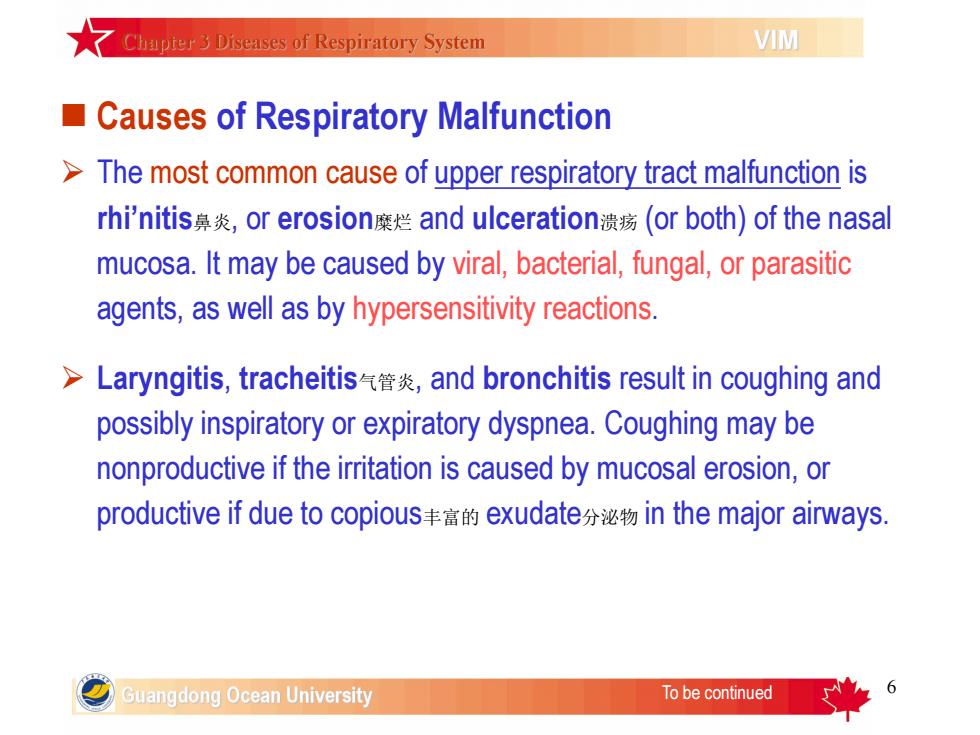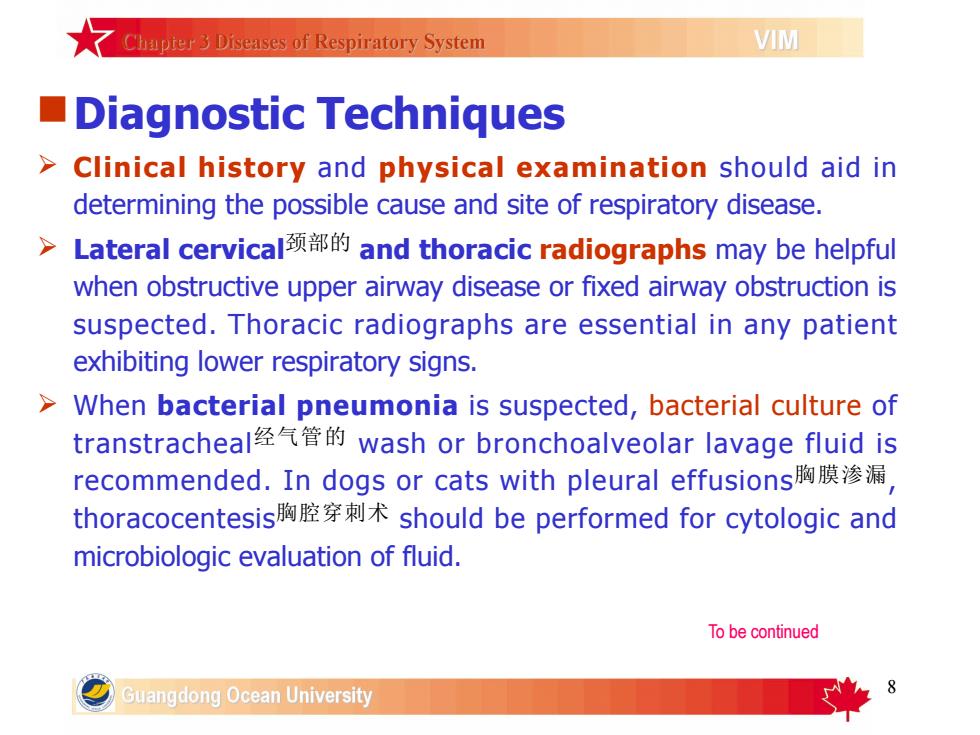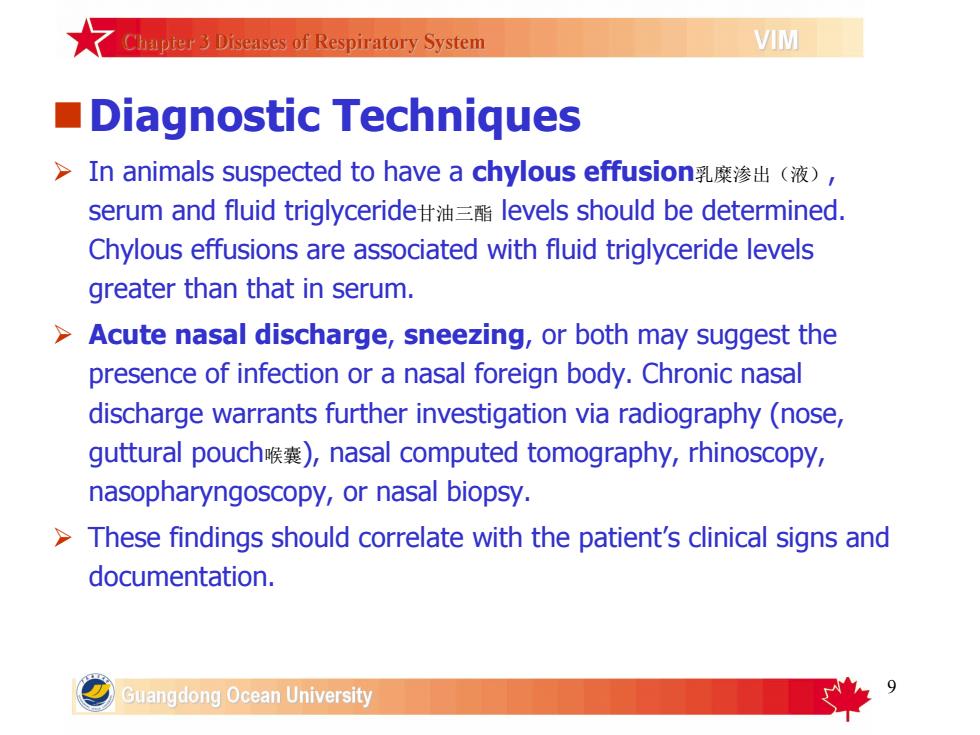
Chapter3Diseases of RespiratorySystemVIMCauses ofRespiratoryMalfunction> Themostcommon cause ofupperrespiratorytract malfunction isrhi'nitis鼻炎,or erosion糜烂andulceration溃疡(orboth)of thenasalmucosa. It may be caused by viral, bacterial,fungal, or parasiticagents,aswell asbyhypersensitivityreactions>Laryngitis,tracheitis气管炎,andbronchitisresultincoughingandpossibly inspiratory or expiratory dyspnea.Coughing may benonproductive if the irritation is caused by mucosal erosion, orproductive if due to copious丰富的 exudate分泌物 in the major airwaysTobecontinuedGuangdong Ocean University
6 n Causes of Respiratory Malfunction Ø The most common cause of upper respiratory tract malfunction is rhi’nitis鼻炎, or erosion糜烂 and ulceration溃疡 (or both) of the nasal mucosa. It may be caused by viral, bacterial, fungal, or parasitic agents, as well as by hypersensitivity reactions. Ø Laryngitis, tracheitis气管炎, and bronchitis result in coughing and possibly inspiratory or expiratory dyspnea. Coughing may be nonproductive if the irritation is caused by mucosal erosion, or productive if due to copious丰富的 exudate分泌物 in the major airways. To be continued

VIMChapter3Diseases of Respiratory SystemCausesof RespiratoryMalfunctionThe initial problem in many pneumonias is thought to be a suddenalteration in the normal nasal bacterial flora, which results in asuddendramatic increasein one ormore speciesof bacteria.Thesebacteria are breathed into the lung in large numbers and mayoverwhelm the normal defense mechanisms, localize, multiply, andinitiate inflammation.Inaddition,stressisoftenaprecursorof viral respiratoryinfectionsparticularly in groups of animals that have recently been congregatedand stressed by travel, handling, and mixingPneumoniaalso can be caused bydirect infection withvirusesbacteria,and fungi,as well asbytoxins arriving hematogenouslyi血源地by inhalation, or by aspiration of food or gastric contents.Suangdong Ocean University
7 Ø The initial problem in many pneumonias is thought to be a sudden alteration in the normal nasal bacterial flora, which results in a sudden dramatic increase in one or more species of bacteria. These bacteria are breathed into the lung in large numbers and may overwhelm the normal defense mechanisms, localize, multiply, and initiate inflammation. Ø In addition, stress is often a precursor of viral respiratory infections, particularly in groups of animals that have recently been congregated and stressed by travel, handling, and mixing. Ø Pneumonia also can be caused by direct infection with viruses, bacteria, and fungi, as well as by toxins arriving hematogenously血源地, by inhalation, or by aspiration of food or gastric contents. nCauses of Respiratory Malfunction

7Chapter3Diseases of Respiratory SystemVIMDiagnosticTechniquesclinical history and physical examination should aid indetermining the possible cause and site of respiratory disease>Lateral cervical颈部的 and thoracic radiographs may be helpfulwhen obstructive upper airway disease or fixed airway obstruction issuspected.Thoracic radiographs are essential in any patientexhibiting lower respiratory signs.> When bacterial pneumonia is suspected,bacterial culture oftranstracheal经气管的 wash or bronchoalveolar lavage fluid isrecommended. In dogs or cats with pleural effusions胸膜渗漏thoracocentesis胸腔穿刺术 should be performed for cytologic andmicrobiologic evaluation of fluid.Tobe continuedGuangdong Ocean University
8 nDiagnostic Techniques Ø Clinical history and physical examination should aid in determining the possible cause and site of respiratory disease. Ø Lateral cervical颈部的 and thoracic radiographs may be helpful when obstructive upper airway disease or fixed airway obstruction is suspected. Thoracic radiographs are essential in any patient exhibiting lower respiratory signs. Ø When bacterial pneumonia is suspected, bacterial culture of transtracheal经气管的 wash or bronchoalveolar lavage fluid is recommended. In dogs or cats with pleural effusions胸膜渗漏 , thoracocentesis胸腔穿刺术 should be performed for cytologic and microbiologic evaluation of fluid. To be continued

ZChapter3Diseases of Respiratory SystemVIMDiagnostic Technigues>In animals suspected to have a chylous effusion乳糜渗出(液),serum and fluid triglyceride甘油三酯 levels should be determinedChylous effusions are associated with fluid triglyceride levelsgreater than that in serum.Acute nasal discharge, sneezing, or both may suggest the中presence of infection or a nasal foreign body. Chronic nasaldischarge warrants further investigation via radiography (nose,gutturalpouch喉囊),nasal computed tomography,rhinoscopy,nasopharyngoscopy,ornasalbiopsy These findings should correlate with the patient's clinical signs anddocumentation.Suangdong Ocean University
9 nDiagnostic Techniques Ø In animals suspected to have a chylous effusion乳糜渗出(液), serum and fluid triglyceride甘油三酯 levels should be determined. Chylous effusions are associated with fluid triglyceride levels greater than that in serum. Ø Acute nasal discharge, sneezing, or both may suggest the presence of infection or a nasal foreign body. Chronic nasal discharge warrants further investigation via radiography (nose, guttural pouch喉囊), nasal computed tomography, rhinoscopy, nasopharyngoscopy, or nasal biopsy. Ø These findings should correlate with the patient’s clinical signs and documentation

7Chapter3Diseases of Respiratory SystemVIMControl/PreventionofRespiratoryDiseaseSuddendietarychanges,weaning,cold,drafts贼风,dampnessdust,high levels ofammonia,poor ventilationin general, andthe mixing of widely divergent age groups all play a role inrespiratory disease in groups of animals.Stress and mixing of animalsfrom several sources shouldbeavoided or minimized.Establishingindividualanimal identification,makingaccurate clinicalandpostmortem检diagnoses,andmaintaining a recordsystemofdiagnosis and treatment are important to minimizeor control outbreaksofpneumonia.Immunization can help control respiratory disorders, using vaccinesand opsonization免疫调节.10Guangdong Ocean University
10 n Control / Prevention of Respiratory Disease Ø Sudden dietary changes, weaning, cold, drafts贼风, dampness, dust, high levels of ammonia, poor ventilation in general, and the mixing of widely divergent age groups all play a role in respiratory disease in groups of animals. Stress and mixing of animals from several sources should be avoided or minimized. Ø Establishing individual animal identification, making accurate clinical and postmortem尸检 diagnoses, and maintaining a record system of diagnosis and treatment are important to minimize or control outbreaks of pneumonia. Ø Immunization can help control respiratory disorders, using vaccines and opsonization免疫调节